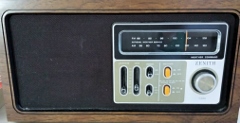Does your forecast look like a radio? No? Then don’t treat it like one.
 A radio’s tuning knob serves a valid purpose. It lets you make fine adjustments, improving reception of the incoming signal, resulting in a clearer and more enjoyable listening experience.
A radio’s tuning knob serves a valid purpose. It lets you make fine adjustments, improving reception of the incoming signal, resulting in a clearer and more enjoyable listening experience.
Does your forecast look like a radio? No? Then don’t treat it like one.
 A radio’s tuning knob serves a valid purpose. It lets you make fine adjustments, improving reception of the incoming signal, resulting in a clearer and more enjoyable listening experience.
A radio’s tuning knob serves a valid purpose. It lets you make fine adjustments, improving reception of the incoming signal, resulting in a clearer and more enjoyable listening experience.
But just because you can make fine adjustments to your forecast, doesn’t mean you should. In fact, you shouldn’t.
Two Things Can Happen — And One of Them is Bad
Famed college football coach Woody Hayes (fired unceremoniously in 1978 for punching an opposing player) was know for powerful teams that ran the ball, eschewing the forward pass. Of the latter, he is credited with saying “When you pass the ball three things can happen, and two of them are bad.” [For those unfamiliar with American football, the good thing is a pass completion, and the bad things are an incompletion or an interception by the opposing team.]
Whenever you adjust a forecast two things can happen — you can improve the accuracy of the forecast, or make it worse.
Obviously, if you make the adjustment in the wrong direction (e.g., lowering the forecast when actuals turn out to be higher), a bad thing has happened — you’ve made the forecast worse. But you can also make overly aggressive adjustments in the right direction and overshoot, making the forecast worse. (For example, initial forecast of 100, adjusted forecast of 110, actual turns out to be 104.)
When you make just a small adjustment, there is little chance of overshooting. So as long as you are directionally correct, you have improved the forecast. But even if we assume every small adjustment is directionally correct, is that reason enough to spend time making small adjustments?
No. And here’s why not:
First recognize that “small adjustment” means small as a percentage of the original forecast. So changing a forecast from 100 to 101 is a “small” adjustment, just 1%. Likewise, changing 1,256,315 to 1,250,000 would be considered a small adjustment (0.5%) even though the change is over 6300 units.
Another way to characterize adjustments is their relevance — whether they are significant enough to cause changes in decisions and plans.
On this criterion, small adjustments are mostly irrelevant. An organization is probably not going to grind to a halt, scuttle existing plans, and suddenly change direction just because of a 1% adjustment in a forecast.
[Note that even “large” forecast adjustments may be irrelevant, when they don’t require any change in plans. This could happen for very low value items, such as 1/4″ galvanized washers sold at a hardware store. Such items are usually managed via simple replenishment rules, like a two-bin inventory control system. Unless the forecast change is so large that current bin sizes are deemed inappropriate, no action will be taken.]
Can’t Small Adjustments Make a Big Improvement in Accuracy?
It’s true that even a small adjustment can make a big improvement in forecast accuracy. Changing the forecast from 100 to 101, when actuals turn out to be 102, means you cut the error in half! (On the other hand, if actuals turned out to be 200, then you only reduced forecast error by 1%.)
But the purpose of forecasting is to help managers make better decisions, devise better plans, and run a more effective and profitable organization. Improved forecast accuracy, in itself, has no value unless it results in improved organizational performance.
So if a small forecast adjustment does not change any of the behavior (or resulting outcomes) of the organization — why bother??? Making small adjustments takes effort and resources, but is simply a waste of time.







